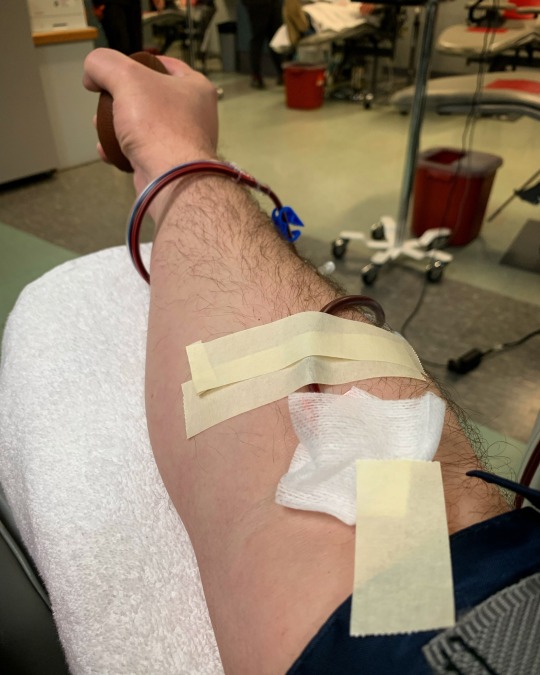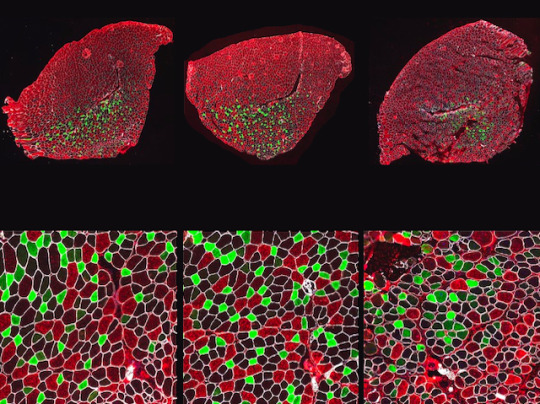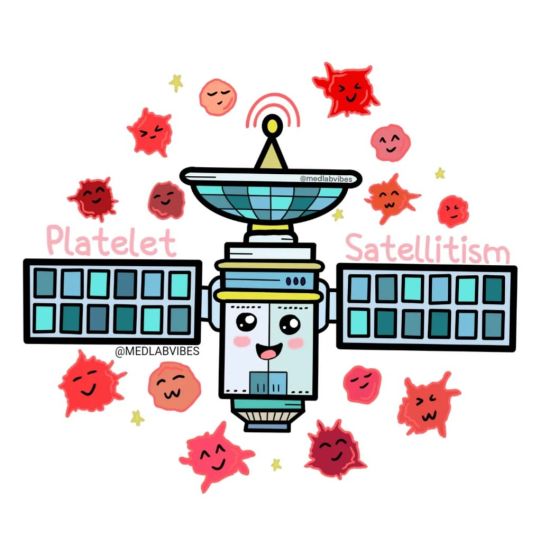#platelets
Text
So I finally tried to donate platelets again today. I had hoped taking a few weeks off would let my scar tissue heal up.
Unfortunately, no. They couldn't get my blood to flow and the pain was so bad I had to tap out.
I started crying and the poor little Tech was so distressed and kept apologizing. I reassured her that my tears weren't because of the pain, or anything she did.
The tears were because it looks like I can't donate anymore. And I feel like this was the one good, unselfish thing I could do for the world. It made me feel good to donate and know I was helping people.
Sadly my left arm is not suitable for donations because of vein placement. 😔

15 notes
·
View notes
Text

They call it a platelet donation, but they actually take a whole bunch of them.
#platelets #blood #donation #phlebotomy #thrombocytes
9 notes
·
View notes
Photo

Mending Muscles
Your blood contains cell fragments – platelets – that can supercharge muscle repair. It's why platelet-rich plasma injections are used to treat muscle injuries. Researchers investigate why this works using fluorescence microscopy of uninjured and injured mouse muscles (pictured). Platelets accumulated after injury and antibody treatment to deplete injured muscles of platelets prevented immune cells called neutrophils from accumulating in these muscles. This also impaired repair. As platelets release chemical messengers called cytokines, researchers measured cytokine levels after injury in normal and platelet-depleted muscles. Platelet depletion reduced levels of the neutrophil-attracting cytokines CXCL5 and CXCL7. Comparing muscles from normal mice (before injury, left; 2 weeks later, middle) and those lacking CXCL7 (2 weeks after injury, right), revealed mice lacking CXCL7 recruited fewer neutrophils upon injury and 2 weeks later had smaller muscle fibres (zoom, bottom right). Platelet-derived CXCL7 therefore promotes muscle repair via neutrophils – this pathway could be exploited to boost repair.
Written by Lux Fatimathas
Image adapted from work by Flavia A. Graca and colleagues
Department of Developmental Neurobiology, St. Jude Children’s Research Hospital, Memphis, TN, USA
Image originally published with a Creative Commons Attribution 4.0 International (CC BY 4.0)
Published in Nature Communications, March 2023
You can also follow BPoD on Instagram, Twitter and Facebook
#science#biomedicine#muscles#platelets#cytokine#immunofluorescence#neutrophils#muscle repair#muscle injury
13 notes
·
View notes
Text

#love#anime memes#anime#funny#humor#jokes#memes#cells at work#anime funny#cells at work platelets#platelets#red blood cells#white blood cell
4 notes
·
View notes
Text
🥳🥳
I'm really happy.. feels like an understatement I have been heard And we are investigating my shit immune system!!
🥳🥳
😅For those that want the deets😅
I met with my new Hematologist.
He wanted to go over my ITP history FROM THE BEGINNING! He was shocked how much I had in my head without notes.
I told him what treatments have yielded no platlet responses over the years and how most my drops since 2013 have been immune system triggered or medication triggers (like vaccinations)
He wanted me to take a daily med that stimulates the bone marrow to produce more platlets but these meds have only been out 10 years and were approved as orphan drugs. I have followed these meds the last ten years. I'm not on board with these. MORE SO, I DO NOT have Chronically low numbers. Mine are event drops.
This HOUR long, one on one appointment with him ended with him agreeing that
* I am on top of this
*I manage this condition well
*I can have IVIG infusions when i drop below 20
AND! AND!
since it's tied so to my immune system,
My severe infection history & routine home mitigation, & I respond SO WELL to IVIG w/o roids I am being sent to the immunology department to be checked for IgG Deficiency, CVID & other autoimmune issues. They will follow up with rheumatology should they find anything but both referral sent.
I already have intake appointment with them! I know this isn't likely going to be a fast thing but the possibility of some answers and maybe not end up in the hospital when I get sinus infection or UTI would be really nice.
#itpwarrior#platelets#immune thrombocitopinia purpua#idiopathic thrombocytopenia#autoimmine disease#trachel stenosis#fibromyalgia#CVID#igg deficiency#ivig#iv infusion therapy
4 notes
·
View notes
Photo


#studyblr#notes#medblr#medical notes#med notes#blood clotting factors#blood factors#phlebotomy#phlebotomy notes#blood content notes#blood content#blood proteins#proteins in blood#proteins#clotting factors#clotting factors notes#platelets#factor xii#factor xi#fibrinogen#fibrin#factor xiii#hageman factor#factors in blood#blood factors notes
23 notes
·
View notes
Text
Just finished reading Cells at Work! Platelets what am I supposed to do now
4 notes
·
View notes
Text
Cells at Work: "Here's how your body works!"
Cells at Work Code Black: "here's how your decisions stop your body working"
#cells at work#cells at work code black#red blood cell#white blood cell#platelets#I love both of these#in different ways#manga#anime
2 notes
·
View notes
Text
Off to my platelet donation appointment. Check you later. 💜😊👍
4 notes
·
View notes
Photo

Platelet satellitism: where platelets aggregate around a blood cell creating a "satellite" appearance 🛰️ #lablife #labtech #laboratorymedicine #medlab #microbiology #labwork #labresults #labsafety #labscience #labprofessionals #medlabscience #medlabscientist #medicallaboratoryscience #medicallaboratoryscientist #medicallaboratorytechnologist #laboratorylife #scientist #hematology #bloodbank #platelets #nursing #hematologia #hematology_lab https://www.instagram.com/p/CnXqF4fOWHQ/?igshid=NGJjMDIxMWI=
#lablife#labtech#laboratorymedicine#medlab#microbiology#labwork#labresults#labsafety#labscience#labprofessionals#medlabscience#medlabscientist#medicallaboratoryscience#medicallaboratoryscientist#medicallaboratorytechnologist#laboratorylife#scientist#hematology#bloodbank#platelets#nursing#hematologia#hematology_lab
2 notes
·
View notes
Quote
I take chlorophyll to help build my platelets during pregnancy. It works! I take it with young coconut water. It acts like a natural blood transfusion. It's my go to drink during labor. I can tell you that after birth, the bleeding has always been minimal. And my babies have benefited from it too! :)
@akerfam via babycenter.com
4 notes
·
View notes
Text
Miniaturized submarine in a human artery.








In the not-so-distant future, a team of intrepid explorers and doctors embarked on a mission unlike any before. They were part of Project InnerSpace, a revolutionary medical program designed to treat diseases from within the body at a cellular level.
The crew boarded the Proteus, a state-of-the-art submarine no larger than a human cell, engineered to navigate the complex environment of the human bloodstream. Their patient was a renowned scientist who had fallen ill with a rare condition that no conventional treatment could cure.
As the Proteus was injected into the scientist’s vein, the crew felt a momentary lurch as they were rapidly miniaturized and entered the bloodstream. Captain Eva Torres took the helm, guiding the vessel with precision through the rushing red rivers of blood cells.
Dr. Liam Kim, the chief medical officer, monitored the vitals of both the patient and the crew. “We’re approaching the liver,” he announced. “Prepare for turbulence.” The Proteus dove into the organ, dodging Kupffer cells and navigating the maze of bile canaliculi.
Their mission was to find and destroy the rogue cells responsible for the scientist’s ailment. Using the Proteus’ advanced laser systems, they targeted the diseased cells, disintegrating them without harming the surrounding healthy tissue.
The journey was perilous. White blood cells, the guardians of the body, mistook the Proteus for a foreign invader and swarmed to attack. Quick thinking by the crew and a burst of the submarine’s electro-magnetic pulse sent the white cells into temporary confusion, allowing the Proteus to escape.
Finally, after a harrowing journey through the heart, lungs, and brain, the crew completed their mission. The scientist’s condition was reversed, and the Proteus was extracted from the body.
As they returned to their normal size, the crew of the Proteus celebrated their success. They had not only saved a life but also opened a new frontier in medicine. From that day on, the brave explorers and doctors of Project InnerSpace became legends, their story told and retold as the first humans to voyage through the body’s inner cosmos.
And so, the Proteus and her crew became pioneers, their courage and dedication forever changing the face of medicine.
#ai#ai art#ai artwork#Fantastic Voyage#Miniature#submarine#artery#platelets#spaceship#virus#ai story#generated by ai
0 notes
Text

Platelets are super tiny blood parts that stop bleeding, help wounds heal, and control clotting. Even though they're very small, they do really big jobs to keep us healthy.
#save lives#blood donation#give blood#recipient#donor#platelets#blood donation app#gift of life#donate blood
0 notes
Text
Steps of the Inflammatory Response
Damaged tissues release histamine
Histamine increases blood flow
Histamine causes capillaries to leak
More phagocytes and clotting factors are released
Phagocytes engulf bacteria, dead cells, and cellular debris
Platelets seal the wound
.
Patreon
#studyblr#notes#medblr#medical notes#med notes#inflammatory response#inflammation#immunology#immunology notes#immune system#immune system notes#histamine#capillaries#phagocytes#platelets#wound healing#healing
4 notes
·
View notes

